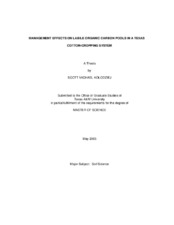| dc.description.abstract | It is well documented that increases in soil organic matter (SOM) improve soil
physical properties and increase the overall fertility and sustainability of the soil.
Research in SOM storage has recently amplified following the proposal that agricultural
soils may provide a significant carbon (C) sink that may aid in the mitigation of
increasing atmospheric carbon dioxide. Observed differences in lint yield and nitrogen
response from a cotton performance study at the Texas A&M University Experimental
Farm near College Station, TX prompted us to examine the effects of tillage and
rotation on soil organic C (SOC), soil microbial biomass C (SMBC), 38-day cumulative
C mineralization (38-day CMIN), hot-water extractable organic C (hot-WEOC),
carbohydrate C, and total glomalin. The treatments examined included conventional-till
continuous cotton (CT), reduced-till continuous cotton (RT), and conventional-till cotton
after corn rotation (CC) treatments. In pre-plant soil samples, SOC, SMBC, and 38-day
CMIN in the top 5 cm were 33, 58, and 79 % greater in RT and 29, 32, and 36 %
greater in CC vs. CT. Comparable differences were observed for hot-WEOC and
carbohydrate C. Little seasonal variation was observed for labile-C pools throughout
the growing season, suggesting minimal C input from cotton roots. Water-stable
aggregation was not significantly affected by management, and did not correlate with
labile-C pools or total glomalin. Labile-C pools were generally more responsive to
management vs. SOC and were strongly correlated with one another. Carbohydrate C
of hot-water extracts exhibited the strongest relationships with SMBC and 38-day CMIN,
even though it comprised only 3 and 5 % of these pools, respectively. Our data suggest
that increasing SOC in Texas cotton-cropping systems through conservation
management is possible. Long-term data are still needed to fully address SOC storage
potentials in Texas, but increases in labile-C pools resulting from conservation
management are attainable and have the potential to positively impact soil fertility. | en |


